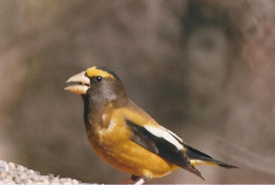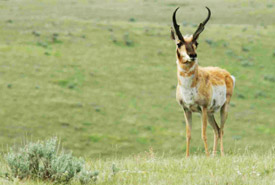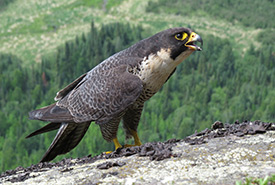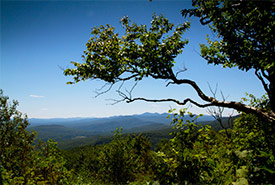Stopping habitat loss is the key to saving Canada’s endangered species

Evening grosbeak (Photo by Anna Tchoulik)
Canada has been losing and saving species for a long time. Since European settlement, over 100 species have been lost here. These include plants and animals that are extinct and extirpated and species that are considered historic (no one has seen them in Canada for a long time). The number of lost species varies between different regions of the country. In the Great Lakes region of southern Ontario, there are extinct species (passenger pigeon), extirpated species (paddlefish) and historic species (Eskimo curlew). There are also species that have vanished from this landscape but still exist elsewhere in Canada. This includes large carnivores, such as black bear and cougar, and plants and smaller wildlife, such as white prairie-clover, spring salamander and Melissa blue butterfly.
The causes of species loss in Canada have varied through time, and include over-hunting, pollution, invasive species, habitat loss and climate change. These mirror the threats to species around the world. Canada has made significant progress in reducing some of these threats, and helping some species to recover.

Pronghorn antelope, Old Man on His Back (Photo by Karol Dabbs)
Over a century ago, many of our game and furbearing animals, such as pronghorn, beaver and marten, had vanished from huge areas of Canada because of unregulated hunting and trapping. Many migratory birds were becoming rare because of over-hunting and commercial harvest. Today, trapping and hunting are not a significant threat to endangered species in Canada. We have also seen an extraordinary recovery of species, such as wood duck and river otter.

Peregrine falcon, ON (Photo by Brian Ratcliff)
When I was kid in the late 1970s, I had posters of peregrine falcons and American white pelicans on my wall. Their populations had drastically declined, in part, because of the pesticide DDT. DDT would accumulate in these birds and cause the shells of their eggs to thin and crack. Without new generations of these birds being born, their populations were declining. When DDT was mostly phased out by the mid-1970s, populations of these birds recovered. While there are still some chemicals that are impacting species, we now know that by reducing environmental pollution, species can recover.
Canadians today should be thankful to those who made the changes needed to help wildlife recover. Introducing new trapping regulations, passing the Migratory Birds Convention Act in 1917 to control hunting and protect birds, and the banning of DDT were not simple feats. But they were necessary, and those conservation actions benefit Canadians and Canadian wildlife today.
Today our challenge to save species is also not simple, but it is equally necessary. Of all the threats to species and of all the factors endangering Canada’s wildlife, the challenge to our generation is stopping habitat loss.
Now, you might have thought climate change is our biggest challenge. But to save species, to prevent the further loss of Canada’s wildlife, we need to save habitat. There is no opportunity for species’ recovery if their habitat is lost. Changes in hunting regulations couldn’t have saved pronghorns if there wasn’t any habitat left. And solving climate change won’t protect species if, in our race to reduce carbon emissions, their habitat disappears.

The Green Mountains Nature Reserve, QC (Photo by Appalachian Corridor)
There are many important initiatives to protect habitat for endangered species and wildlife. Canada's commitment to protect 30 per cent of our land and inland waters by 2030 will help us meet an important conservation milestone, but many of these new protected areas and conservation lands will be in our northlands. This is critical for woodland caribou and wolverines, but many of Canada’s most endangered species live in the southern areas of Canada where most of the land is privately owned. This is also a landscape that is under the most immediate threat. In many regions, we have a one-time opportunity for our generation to protect critical habitats for our most endangered plants and animals.
One of the most important roles of the Nature Conservancy of Canada (NCC) and other land trusts is to work with private landowners to protect habitat for species that are at risk of being lost from Canada. NCC now protects habitat for over 225 species that have been assessed as endangered, threatened or special concern by the Committee on the Status of Endangered Wildlife in Canada (COSEWIC). This growing number reflects both the increasing number of species assessed as at risk by COSEWIC and NCC’s continued focus on protecting lands that provide habitat for our most endangered species.
Over the last few years, with support from the Government of Canada’s Natural Heritage Conservation Program, NCC has documented over 20 new species of endangered wildlife on our properties. Some of these are found on new NCC properties. Some are the result of new information and discoveries, and additions from recent COSEWIC assessments. Some of the species new to NCC’s portfolio of Canada’s endangered wildlife that we help to protect include:
Maritime ringlet (endangered)
The entire range of this small butterfly is restricted to coastal marshes in northern New Brunswick and the southern coast of the Gaspé Peninsula in Quebec. NCC documented this globally rare and nationally endemic butterfly in 2016 on a property in the Southern Gulf of the St. Lawrence.
Lark bunting (threatened)
The global population of this grassland bird has declined by 98 per cent in the last 50 years due to habitat loss. When the species was assessed as threatened by COSEWIC in 2017, NCC had already protected over 30 properties in Alberta and Saskatchewan, including the Wideview Complex in Saskatchewan, that provide the shrinking prairie habitats it needs.
Van Brunt’s Jacob’s ladder (threatened)
This globally rare wildflower was recently discovered on an NCC property in Quebec’s Eastern Townships. Van Brunt’s Jacob’s ladder is rare throughout its range in northeastern Northern America and is threatened by habitat loss.
Evening grosbeak (special concern)
This coniferous forest songbird has been declining throughout most of its range. Threats to the evening grosbeak include loss of mature and old-growth forests. This bird was assessed as special concern by COSEWIC in 2016. At that time, NCC was already protecting nesting and stopover habitat across Canada, including Southwest Nova Natural Area in Nova Scotia, Riding Mountain in Manitoba and the Salish Sea in BC.
Hine’s emerald (endangered)
The Canadian distribution of the globally rare Hine’s emerald dragonfly is restricted to the Minesing Wetlands, just west of Barrie, Ontario. In 2017 and 2018, NCC protected two properties where the Hine’s emerald has been recorded. In addition to habitat protection, NCC will also be restoring wetlands on the Patrick W. E. Hodgson Property over the next few years to create additional habitat for this species.
Habitat is the lynchpin of wildlife conservation. There are important successes in recovery and discovery that we need to share. But most importantly, we need to do more conservation and we need to do it faster. No one else can save Canadian wildlife except Canadians.


